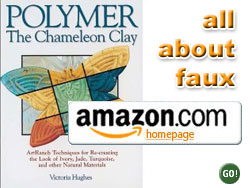
Faux Amber Jewellery from Polymer Clay – Books by Victoria Hughes
“Polymer – The Chameleon Clay” — An excellent book for learning about making poly clay faux jewelry and beads:
More...
Faux ivory, jade, turquoise and other natural materials (aka very cool fake stones). Sometimes it takes someone from halfway around the world to get me to write about my favorite polymer clay books. Today’s recommendation is for a book by Victoria Hughes. The title is Polymer – The Chameleon Clay. **(Affiliate Link)
One of the greatest things about the Internet for the jewelry artist is the ability to connect with other artists from all over the world.
Blogs and websites, written thousands of miles away, can be viewed through the click of a mouse. Languages can be translated with automatic translator tools, and emails and videos can be sent in an instant.
A fantastic example of this amazing level of communication is a letter I received from Marcia in Chile.
Translation to English (Using the Google Translation Tool):
As the Polymer Clay Tutor, hardly anything excites me more than being able to teach and learn from people that I would not normally get to interact with. I have never been to Chile and I can not speak Spanish, but here we are talking away!
Marcia – Thank you so much for your comment! I love it that you are writing from Chile!
The best book I can recommend on faux amber is Polymer – The Chameleon Clay**(Affiliate Link) by Victoria Hughes. This book has excellent, accurate information and great faux stone recipes. The photos of the finished pieces are gorgeous, too!
Later, when I can get some time, I will publish more specific articles about faux techniques and instructions for polymer clay.
Hope this helps,
Cindy Lietz, Polymer Clay Tutor
Translation to Spanish (Using the Google Translation Tool):
Cindy Lietz, Polymer Clay Tutor
So even a Chilean Sculpey Clay or Fimo artist like Marcia, writing in a language I don’t even understand, can get a little help with her faux amber jewelry making projects. This world keeps getting a little smaller, friendlier and a lot more helpful! Muchas gracias Marcia!
Sponsored Ads & Special Promotions


Want to chat about today’s post? That’s what the comment section below is for. Scroll Down… We’d love to hear from you!
Or... if you would like to request a topic for a future post, here is the link to do that… PcT Suggestion Box

Yes there are a lot of tricks to baking polymer clay beads Sue! If you click the link by my name you will find a post that will help you with baking your beads. You should find the info interesting and a real help!
At the risk of sounding self serving You’re right, the course would be a great thing for you. It would save you a lot of hassle and money trying to figure things out on your own. Click the ‘Bead Making Courses’ link at the top header bar of this blog and you will find out all about the course.
Hope that helps!
Making faux opals is what first got me interested in polymer clay. Haven’t made any yet, but have been playing with clay for a few days now and I’m hooked. Now, if I could only figure out how long to bake my pieces for them to be properly cured, I’d be happy! If a piece is 1/8″ thick, fifteen minutes doesn’t seem to be long enough. I’ve only done three bakings. The first time, the beads (white/pearl mixture) darkened from too much heat. The second and third times, the pieces weren’t baked long enough, I think, as they were still flexible after they cooled. My toaster oven temp really varies a lot, and takes forever (nearly 20 minutes) to preheat, although putting a couple of ceramic tiles in the bottom seems to help it to hold the temperature better. I guess I should really subscribe to your lessons, Cindy. Your blog is excellent.
I finished, and thoroughly enjoyed the treasure hunt. I learned so much today along the way! I found many pages that I had not seen before, and I had to read them all! I just love all of your blog. You can be sure that I will be coming back many more times to learn all that I can from your experiences in Polymer Clay… and just having fun reading your writings as well! Thank you for sharing your great talent!!! PS I thought it was really cool when I saw your post on the Wet Canvas web site in the clay section. I thought, hey! I know who Cindy Lietz is!!! Your friend
Yeah I know Cynister… there are several different ways to make Opals and some of them just aren’t that great! I am still experimenting with a few different techniques. When I get a result I like and think is easy enough, I will make a course on it. I think it something that a lot of people would like to learn how to make.
Cindy Lietz’s last blog post..Millefiori Beads by Polymer Clay Cane Artist Iris Mishly [Israel]
I haven’t tried faux amber yet, but I did try a bunch of other techniques a few weeks ago. Some came out nice like the abalone, goldstone & moss agate methods, while others left a lot to be desired (opals, labradorite, agate slices). I wish I could have gotten the opals to work better. I really like the idea of creating something that looks like stones. It gives you so many more options in making jewelry.
I think you’v been doing a great job at asking questions Marianne!
Cindy’s last post..Making Beads with a Mod Polymer Clay Cane for Cool Jewelry Projects
I am really interested in making the faux amber beads.
I keep wiggling my way through all the interesting notes and have a longggggggg shopping list.
Thank you,
Marianne
PS..I don’t know enough to know what questions to ask.
Please tell me your level of interest is in faux amber jewellery or faux polymer clay projects. Do you have any specific questions that you would like me to answer?
Cindy Lietz’s last post..Bead Making Conspiracy – Polymer Clay Tutor’s Evil Plan Exposed